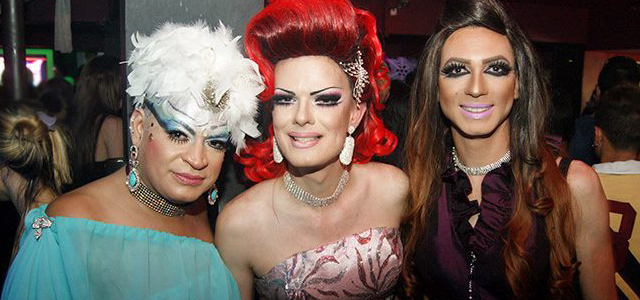With tradition, good mood and determination, artists from the capital of Paraná face barriers to persue their career
Victória Tuler and Lucas Panek
Born in 1992, when she performed at the opening of a bar in Maringá, Brigitte Beaulieu became one of the most famous and important drag queens of Curitiba. She worked for more than ten years performing at events and nightclubs. Currently, maintaining a schedule of three professional commitments per weekend, Beaulieu is categorical about the future of drag culture in Curitiba: “If you want to start, my tip is: just don’t”. The complaints of curitibanas drag queens refer to lack of recognition and low salaries.

Brigitte Beaulieu, in the middle, and Anne Summers, on the right, at an event that celebrated the 15th aniversary of Cats Club (Photo: Lado A magazine)
In Brazil, the first “drag queens boom” happened in 1994, along a movie called The Adventures of Priscilla, Queen of the Desert. The sucess of this film promoted drag art as an important part of pop culture pattern. Between 1996 and 1998, the professionals were employed more frequently to make appearences in social events like graduations and weddings.
Brigitte arrived in Curitiba exactly in 1994. The parties were her gateway to the Curitiba’s cultural scene. “Drags were popular. There was not prejudice”, guarantees her. Her face became known when she joined the Cats Club team – one of the most popular nightclubs in the capital, where she worked for more than eight years. “I’m very grateful to that experience, but currently, I only attend to these establishments for fun, meet old friends or have a beer”, she said.
Difficulties
“In art terms, curitibanas drag queens are dying. Cats Club is the only one that still has a schedule of shows” opines Anne Summers, winner of several drag competitions. Since her childhood, Anne’s plays consisted of wearing female clothes and voicing children’s songs. Her live is marked by bullying at school, prejudice and about a year without contacter with her mother due to their sexual orientation, Summers met the world that would change her life forever when she was 21 years old
“I went to a concert hall and met a drag, Victoria Winner. Discovered by chance that we were neighbors, we became great friend and she realized I had talent”, says Summers. Today, none of the spaces that were exhaust valves for Summers is opend for presentations, either have closed their door or have died out of its programming weekly shows. “Most houses only brings famous names from São Paulo to perform from time to time, and only to attract public”, explains. In Sao Paulo, the presence of drag art in cultural scene is still very strong. Curitiba has about 15 bars and clubs classified as spaced aimed at LGBT audiences. Despite the significant number, the professionals of area can’t reach the deserved recognition for their work. “The most famous Drag Queens I know have other jobs or only perform once in a while”, says Brigitte.
Summers, who is independent of the drag art to survive and dresses as a hobby, says she has even made shows for free in Curitiba. “Not worth it. We spent, like, $ 150 for making a presentation clothing and received a cache of $50, “she says. For her, the problem is that the establishments of gay public lost their identity. “Now has many heterosexual businessmen who own LGBT bars. These people do not know the cause GLS, do not understand what we like” she says. “If you want to start, my tip is: just don’t” suggests Brigitte. “But if you need to, if feel that is no other way, my tip is: you need to study. You need to read, you need to research, to go to workshops, because it’s never easy, “she concludes.